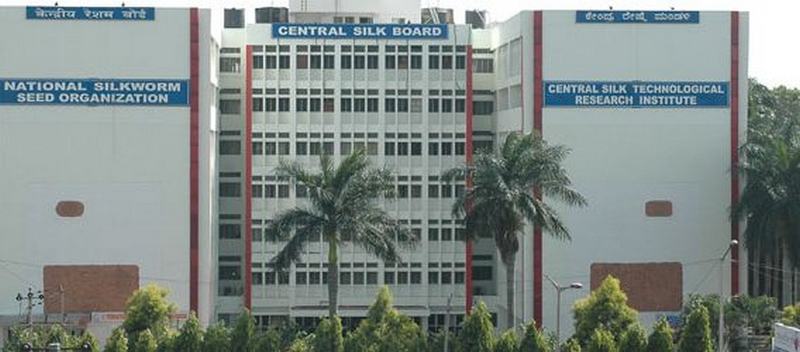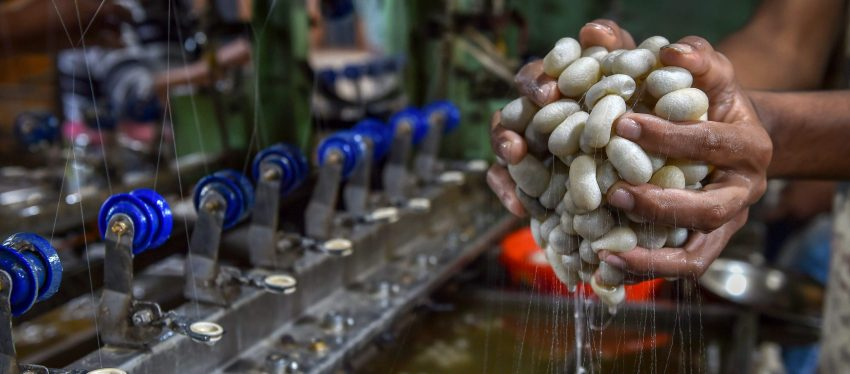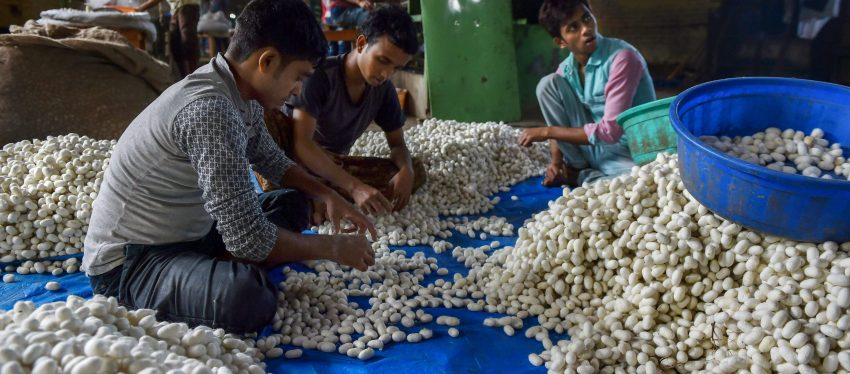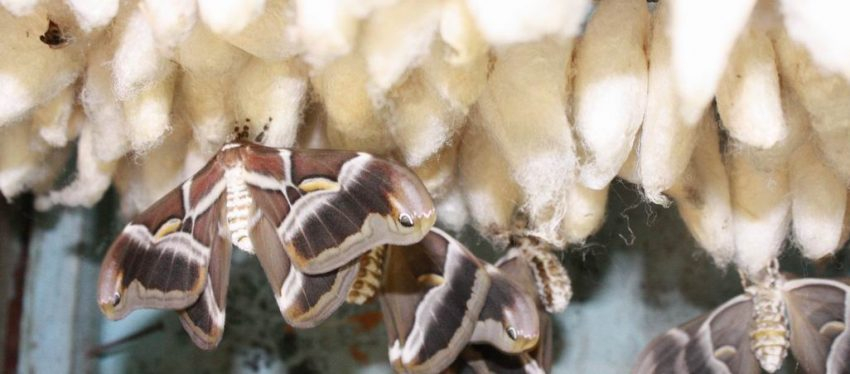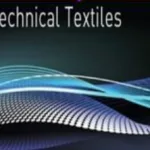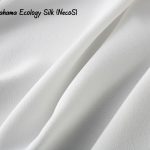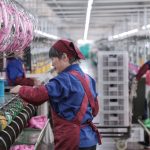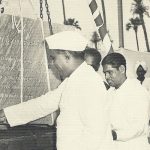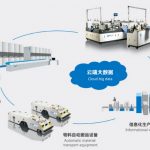The 65th meeting of Research Coordination Committee of Central Silk Board
The 65th meeting of Research Coordination Committee of Central Silk Board was held last month at CO-Bengaluru and Dr. V. Sivaprasad, Director [Tech.] & Member Convener of RCC, extended a warm welcome to Dr. S. Ayyappan, Chairman of RCC; Shri. Rajit Ranjan Okhandiar, Member Secretary, CSB & Vice Chairman of RCC; Members/Invitees of the RCC and other participants attending the meeting both physically and virtually through Webex platform.
Dr. S. Ayyappan, Chairman, RCC welcomed the RCC Members and other participants to the meeting and in his opening remarks, thanked all the RAC Chairpersons of CSB R&D institutes for completing the RAC meetings before the RCC meeting. He reiterated that RAC meetings of major R&D Institutes may be conducted for two days for enabling thorough discussions on every project. He further thanked Member Secretary, CSB for posting Directors to R&D Institutes and complimented the team RCS for meticulously preparing the agenda and explanatory notes and circulating it well before the meeting. RAC Chairpersons were requested to look in to the Scientists deployment at respective institutes as indicated in the agenda notes in the best interests of Sericulture R&D.
Further, he suggested that the Directors hold monthly meetings with scientists about their research activities to bring best out of them for overall improvement of sericulture industry. Requisite facilities/work environment may be created for effective utilization of potential of the young scientists.
Raising concern on research publications especially in the major Institutes like CSRTI-Mysore, he emphasized on quality research publications in peer reviewed journals. The Chairperson also appreciated the efforts of the R & D Institutes, RCS/CO for coming out with reasonably good number of projects and requested for more efforts in seeking extramural funding/international collaborations.
Opening Remarks
RCC Chairman, after the introductory remarks requested the Members of RCC and RAC Chairs to offer opening remarks.
Dr. S. B. Dandin suggested regular interaction between R& D Institutes (Pre-cocoon), Seed Organization and CSTRI-Bengaluru on silkworm improvement programmes. Further, emphasized the need for review on feedback on ARM functioning and collaborative projects with ISEC/MANAGE/ NAARM on social aspects.
Dr. R. S. Deshpande suggested undertaking research on drudgery reduction in terms of livelihood improvement and more focused efforts towards development of need based technologies. Further, emphasized scientific publications of R&D output should reach global stakeholders.
Dr. Ashok K. Patra reiterated maximization of nutrient use efficiency for sustainable production of quality biomass/feed in silkworm host plants.
Sri Manzoor Ahmad Qadiri briefed the status of sericulture in J & K region and need for local silkworm seed production, requirement of suitable hybrids and strengthening extension/ToT activities.
Prof. Nazeer Ahmed highlighted the need for fruitful collaboration between CSRTI-Pampore and Universities in J&K for region-specific technology development, encouraging ASRs in seed sector, Seri- based IFS and introduction of third crop. He also suggested popularizing sericulture in Kargil/Ladakh.
Dr. Onkar Nath Singh stressed on pre-breeding approaches and core collection of genetic resources in host plant improvement programmes.
Dr. N. K. Krishna Kumar emphasized on policy decisions for achieving self sufficiency in the silk sector and reiterated the need for strengthening of Biotechnology research in vanya sector. Further, expressed need for focused research on land to lab concept for productivity improvement.
Dr. Chandish R. Ballal emphasized database maintenance of Seri genetic resources with CSGRC-Hosur and emphasized for networking projects between the R&D Institutes.
Prof. G. Subramanya stressed on need of collaborative research among R&D institutes, importance of biometric analysis in crop improvement programmes and farmers feedback based project formulation.
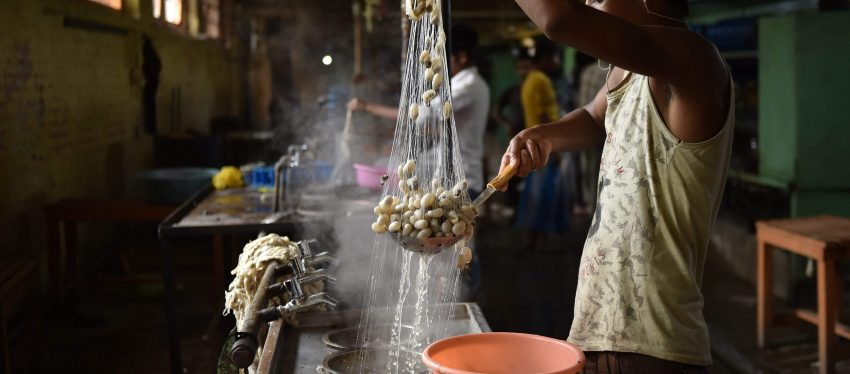
Suggestions
The follow-up action taken on the decisions/recommendations of the previous meeting held on 2nd & 3rd February, 2021 were presented by Dr. S. Manthira Moorthy, Scientist-D, RCS. While approving the action taken report, the committee made the following suggestions.
- Formulation of multi-networking projects among seri-sectors to avoid duplication facilitating accelerated research works. Further, small-sized projects may be combined and propose institutional or networking projects. However, short-term projects may also be encouraged in specific areas.
- Dynamic disease and pest incidence/infestation calendar for all rearing seasons/crops should be available online.
- Explore the possibility of registration of chemical formulations/insecticides/disinfectants developed by CSB R&D institutes with Central Insecticide Board & Registration Committee (CIB&RC), Directorate of Plant Protection, Quarantine & Storage, DAC&FW, MoA&FW.
- PIs invariably need to consult Statisticians for experimental design, planning and analysis during initial project preparation itself. Further, institutes may take the help from other Institutes, if the statistician is not available within the institute.
- Database of CSB-IPs may be established to identify best sericultural technologies/IPs (20-25 nos).
Further, a valuation system/protocol needs to be developed by IP&BP cell for technology commercialization. - RCC members to be contacted through group mail for interaction on important activities and project approvals. For effective & efficient project monitoring in CSB, e-tracking system should be implemented at the earliest.
- A workshop on Socio-Economic Assessment of Sericulture Technologies may be organized under the guidance of Dr. R. S. Deshpande (RCC-Member) for CSB scientists through virtual/offline mode. Besides, a study to assess the impact of technologies needs to be undertaken at the earliest utilizing the expertise available with RCC members and subject matter experts.
- While presenting the CSB progress in the RCC meetings, Global silk scenario may also be presented. Various economic models (eg. intensive/extensive/tree plantation/integrated/irrigated/rainfed/ block/bund etc.) across sericulture sectors to be computed by CSB institutes in association with Statistics Section, CO-Bengaluru.
- Cost of production of cocoons may be estimated periodically in comparison with local agri/horti crops.
- Directors/In-charge Officers should ascertain the training needs of young scientists and make required platform for knowledge up-gradation in frontier areas of research viz., genomics, bioinformatics etc.
- Establishment of seri-based incubation centres at institute campuses on priority basis during the current year (2021-2022) to attract business startups on technologies developed to promote sericulture
- Regular meetings may be conducted with SDD and SKUAST (J&K) for undertaking ToT activities in the field for better interaction/collaboration. Prof. Nazeer Ahmed, Chairperson RAC, CSRTI, Pampore is requested to coordinate the meetings.
- Emphasizing the vanya sector, a one day brainstorming workshop may be conducted on Muga/Eri/Tasar culture separately.
- Refresher training programmes may be organized to the entrepreneurs of Automatic Reeling Machines (ARM) for effective functioning and monitoring production of 4A grade raw silk.
- For effective utilization of sericulture germplasm resources, CSGRC-Hosur should network all the R&D institutes and each Institute should designate a Nodal scientist for relevant interactions.
Review of Research and Development Institutes: New Projects Initiated, Concept notes & ToTs and Concluded Projects (January 2021 – July 2021).
The objectives, methodologies & expected outcomes of newly initiated projects/concept notes and outcome & utility of concluded projects were presented by CSB R&D institutes. After detailed deliberations, the following suggestions/recommendations were made by the Committee.
- PowerPoint presentations should not be cramped and be more legible/readable. The presenters are expected to be explaining rather than a read-out. The presentations should also contain burning issues and strategies to be adopted with each sector.
- RACs to rigorously monitor the progress of on-going projects and facilitate meaningful deliberations on the outcome of concluded projects. RACs should also meet twice a year and might as well be carried out for two days in major institutes. The Agenda and explanatory notes for RAC meetings should also contain minutes of the previous RCC meetings for discussions. RAC meeting minutes should be uploaded in the institute website.
- To formulate national/international project proposals in collaboration with UN/DBT etc. for up- liftment of weaker sections, women empowerment and drudgery reduction.
- P4 stations should only supply P3 dfls; dfls at other levels could be prepared/supplied by DOS/NSSO.
- To prepare time-bound action plan for enhancing the production of Oak Tasar, as this is presently being imported in the country.
- All progenitors/concerned institutes to maintain/strengthen the breeders stocks (host plants) for timely supply to the stakeholders.
- The regional issues of West Bengal, North-Eastern states, Temperate region & Non-traditional areas should be addressed involving DoSs.
- Strategies may be developed to utilize silk waste and cocoons locally as they are currently being exported to China.
- The investigators should identify the potential users of project output for more clarity on future utilization of technologies/products, while formulating new project proposals.
- Germplasm database available with the R & D Institutes needs to be shared with CSGRC-Hosur.
- To conduct national/international level webinar on prospects of sericulture including climate smart sericulture.
Institute Specific Recommendations
New Projects
The list of new projects
CSR&TI-Mysuru: CSB coded projects were ratified and five new concept notes viz., CSB/MYS/RCN 014, 066, 069, 072, 089 & ToT project components were approved.
- The project on non-destructive test of the silk fabrics should be undertaken in collaboration with CSTRI-Bengaluru
- Specific problems to be addressed needs to be highlighted clearly in terms of drudgery reduction, effectiveness and economics in the mechanization project
- Interactions may be held with Dr. N.K. Krishna Kumar (SBRL-RAC Chairman) on resistance to Chlorantraniliprole in silkworms
- Techno-economic feasibility of M-LAMP over other methods for detection of pebrine to be assessed.
CSRTI-Berhampore: CSB coded project PIB 02010SI was ratified and the ToT project proposal was approved.
- To focus more developmental projects on socio-economic improvement by mulberry sericulture through extra mural funding.
CSRTI-Pampore: Ratified two research projects viz., AIB 03007SI & AIB 03008SI and one concept note CSB/PAM/RCN 041 and ToT were approved with the following suggestions
- Fitness and productivity parameters to be recorded should be clearly mentioned besides tolerance to BmNPV.
- Young scientists involved in breeding work should associate with Scientists from other Institutes.
- To initiate needful steps for self sustenance in seed production with SDD-J&K.
- To organize interaction meeting with regard to cocoon marketing in J&K, with guidance from Dr. R.S. Deshpande, (RCC Member) and Prof. Nazeer Ahmad (RAC Chairperson).
CTRTI-Ranchi: CSB coded new project BPC 04008EF was ratified by RCC; two concept notes CSB/CTR/ RCN 053 & 054 and the ToT components were approved with the following observations.
- As the Pilot Study on Effect of micronutrients on the lustre and quality of tasar silk, does not appear rational, the committee suggested to drop the same.
- Dr. N.K. Krishna Kumar (RAC Chairperson, SBRL), may be invited to interact with the Scientists at CTRTI
CMERTI-Lahdoigarh: Ratified the CSB coded three new research projects viz., CFC 05017MI, ARP 05018MI, MFM 05019MI; two concept notes viz., CSB/CME/RCN 081, 084 & 097 (ToT) were approved.
CSGRC-Hosur: Newly CSB coded project was ratified by RCC ie., AIG 06007SI with the following observations.
- To conserve/preserve mulberry germplasm through pollen cryopreservation in collaboration with NBPGR/IIHR. The regeneration capability of cryo-preserved materials should be undertaken periodically.
- To furnish status of preservation of Vanya host plants.
- Active exploration needs to be taken up for collecting new mulberry accessions on the silk route.
- To compare on leaf productivity of fruit yielding varieties vis-a-vis cultivated mulberry varieties.
- To consult PPV&FRA for registering the precious plant/silkworm genetic stocks for legal protection.
- To strengthen bio-safety measures for preventing cross infectivity from other seri-insects.
- To consult ICAR-IIHR-Bangalore for mode of sale of fruit yielding mulberry GRs.
- To arrange for an interactive session with Dr. Sunil Archak, ICAR-National-Fellow, NBPGR for valuable inputs on germplasm maintenance, conservation and IP issues.
CSTRI-Bengaluru: Three research projects viz., CFW 07020SI, CFC 07021SI, BPC 07022MI were ratified; Three concept notes viz., CSB/CST/RCN 003, 004 & 037 including the ToT components were approved by RCC.
Workshop on potential users of machineries to be conducted inviting all the concerned. 8. SBRL-Kodathi: CSB coded new research project (AIT 08006EF) was ratified including one ToT programme by RCC with following observations.
- SBRL scientists need to get good field exposure to make biotech research more contextual To work in close coordination with other CSB R&D institutes on biotechnology projects.
- To draw a 10 year road map sector-wise on biotechnology aspects to address field problems.
- To focus on development of single test kit for diagnosing silkworm diseases.
- To analyze post cocoon parameters in the BmDNV resistant lines with CSTRI-Bengaluru.
- To identify trait specific markers for undertaking MAS programmes in silkworm.
SSTL-Kodathi: Suggested to explore the literature and work done at CSB Institutes on host plant endophytes for more clarity/insights on the Concept note CSB/SST/RCN 78.
Concluded Projects
The list of concluded projects
CSR&TI-Mysuru: The findings of concluded project-AIT 3628 were approved by RCC and suggested to utilize the output in future silkworm improvement programmes.
CSRTI-Berhampore: The findings of five concluded projects viz., AIB 3602, PIB 3627, ARP 3630, PRE 02001 SI & PRP 02003 SI were approved.
CTRTI-Ranchi: The findings of two concluded projects viz., PPA 4715 & AIT 4727 were approved with the following observations.
- The output of concluded research projects should be effectively utilized in tasar silkworm breed improvement programmes and for enhanced host plant growth and development.
CMERTI-Lahdoigarh: Approved the findings of four concluded research projects viz. PPA 5879, AIT 5887, PPF 5893 & AIB 5894 and suggested to utilize the project output of effectively.
CSTRI-Bengaluru: The findings of two concluded projects viz., CYF 070001SI & CFW 07009SI were approved by RCC with the following observations.
- To appraise the analytical status and performance of ARMs established.
- Studies to be undertaken on micro-structural properties of silk fibres.
- To focus more on commercialization aspects in post cocoon sector and make efforts in Brand promotion in co-ordination with garment Industry.
- To estimate economics of flat silk and silk.
- To prepare blue print for overall development of post cocoon sector in Eastern & North Eastern India.
- To improve efficiency of the developed machineries in consultation with IITs
SSTL-Kodathi: Approved the findings of two concluded projects viz., ARP 3635 & ARP 3634 with the following suggestions.
- BTSSO-Bilaspur and CTRTI-Ranchi should be involved for identifying problems associated with the tasar silkworm seed technology.
- To address the egg retention problem in muga, eri and oak tasar.
- To circulate embryonic chart developed for Muga silkworm to MESSO-Guwahati and its nested units and also to undertake studies validation of the developed seed technology.
Review of Progress of the Silkworm Seed Organizations NSSO-Bengaluru:
- To appraise the average entries of private RSPs in a year in the last 10 years.
- To explore establishment of additional cold storage plant in Bangalore.
- To undertake studies on effect of residual toxicity of pesticides in silkworm egg production.
- To explore business start-ups for quality seed production and supply.
- To strengthen seed multiplication system in Eastern & NE India in association with DOSs.
- To document trend analysis of mulberry silkworm seed sector.
BTSSO-Bilaspur:
- To work vibrantly in association with concerned DOSs & CSB institutes. To find alternatives to leg amputation technique for higher egg recovery in tasar silkworm.
MESSO-Guwahati:
- Pro-active association with concerned DOSs & CSB institutes was suggested.
To Review the R&D Progress in CSB R&D Institutes and to Guide Formulating Quinquennial Review
Mechanism for Concluded R&D Projects
- RCC opined that the current mechanism involving two-tier project monitoring and evaluation by RAC and RCC is more appropriate and a quinquennial review mechanism is not necessary.
Other Subjects
The following issues brought up Dr. S.B. Dandin, Member, RCC and Former Director-CSB, with a power point presentation was discussed elaborately:
- Severe infestation of mites and thrips in mulberry
- Improvement of bivoltine cocoon quality
- Differential performance of double hybrid parents and CSR2
- Entry of private traders in cocoon markets
- Occurrence of Pebrine in seed crops
- Effect of residual toxicity of pesticides on silkworm egg production
- Gap area identification in different silk sectors and researchable issues
- Region based issues to be addressed viz., West Bengal, North East region, Temperate region, Nontraditional areas etc.
- Strengthening of Institutes with specialized subject specialists and inter-institutional coordination
- Undertaking extension, impact analysis and socioeconomic projects
- Strengthening of soil testing laboratories The RCC suggested undertaking necessary steps on the above issues suitably by the concerned CSB R&D institutes/Seed Organizations.
The following books/catalogues published by CSGRC-Hosur were released by the Chairperson and the Member Secretary, CSB/Vice Chairperson, RCC during the meeting:
- Catalogue of Mulberry accessions
- SOP on conservation and maintenance of silkworm germplasm
Sri R.R. Okhandiar, Member Secretary, CSB/Vice Chairperson, RCC thanked the RCC for the deliberations and in his concluding remarks informed that CSB is undertaking Life Cycle Assessment study in the silk sector. Further, he stressed on promotion of international marketing of silkworm commercial seed, expansion of eri in non-traditional areas and utilization of silkworm pupae for neutracetical application.
After the closing remarks by the Chairman and Members of the RCC, the meeting ended with vote of thanks by Dr. S. Manthira Moorthy, Scientist-D, RCS.
List Of Participants
List Of Participants Of the 65th Meeting Of RCC Held During 2nd & 3rd September, 2021 at Central Silk Board, Bengaluru
1. Dr. S. Ayyappan, Chairman, RCC
2. Sri. R. R. Okhandiar, IFS, Vice Chairperson RCC & Member Secretary, CSB, Bengaluru
3. Dr. S. B. Dandin, Member RCC, (Attended through WebEx Platform)
4. Dr. R. S. Deshpande, Member RCC, (Attended through WebEx Platform)
5. Dr. Ashok K. Patra, Member RCC (Attended through WebEx Platform)
6. Dr. H. S. Ginwal, Member RCC (Attended through WebEx Platform)
7. Sri. Manzoor Ahmad Qadiri, KAS, Director-SDD-J&K, Member RCC
8. Smt. J.Sukumari, Joint Director, DOS, Karnataka (Attended through WebEx Platform)
9. Smt. S. Pushpalatha, Deputy Director, DOS, Karnataka (Attended through WebEx Platform)
10. Prof. Nazeer Ahmed, Permanent Invitee
11. Dr. Onkar Nath Singh, Permanent Invitee
12. Dr. N. K. Krishna Kumar, Permanent Invitee
13. Dr. Chandish R. Ballal, Permanent Invitee
14. Dr. Chirantan Chattopadhyay, Permanent Invitee (Attended through WebEx Platform)
15. Prof. P. J. Handique, Permanent Invitee (Attended through WebEx Platform)
16. Prof. Mangesh D. Teli, Permanent Invitee (Attended through WebEx Platform)
17. Prof. G.Subramanya, Permanent Invitee (Attended through WebEx Platform)
18. Dr. V. Sivaprasad, Director (Tech) & Member Convener CSB, Bengaluru
19. Dr. Babulal, Director, CSR&TI-Mysuru
20. Dr. Kishor Kumar, Director, CSR&TI-Berhampore
21. Dr. K. Sathyanarayana, Director, CTR&TI-Ranchi
22. Dr. K. M. Vijaya Kumari, Director, CMER&TI-Lahdoigarh
23. Dr. B.T. Sreenivasa, Director, CSGRC-Hosur
24. Dr. Subhas V Naik. Director, CSTRI-Bengaluru
25. Dr. Sardar Singh, Scientist – D & In-charge, CSR&TI-Pampore
26. Dr. K. M. Ponnuvel, Scientist – D, SBRL-Kodathi
27. Dr. Veeranna Gowda, Scientist – D, SSTL-Kodathi
28. Dr. K. Sashindran Nair, Scientist – D, NSSO-Bengaluru
29. Dr. M. S. Rathore, Scientist – D, BTSSO-Bilaspur
30. Sri. Borpuzari Prabhat, Scientist – D, MSSO-Guwahati
31. Dr. Manthira Moorthy, Scientist – D, RCS, CO-Bengaluru
32. Dr. Jula Nair, Scientist – D, CO-Bengaluru (Attended through WebEx Platform)
33. Dr. P. Kumaresan, Scientist – D, CO-Bengaluru (Attended through WebEx Platform)
34. Sri. H. Rudranna Gowda, Scientist – D, CO-Bengaluru (Attended through WebEx Platform)
35. Sri. Joy N John, Scientist – D, CO-Bengaluru (Attended through WebEx Platform)
36. Dr. V. K. Rahamatulla, Scientist – D, CO-Bengaluru (Attended through WebEx Platform)
37. Sri. Nazeer Ahmed Saheb, Scientist – D, RCS, CO-Bengaluru
38. Dr. Prashanth Sangannavar, Scientist – C, RCS, CO-Bengaluru
39. Dr. Manjunatha G. R, Scientist – C, RCS, CO-Bengaluru
New and Concluded Projects
